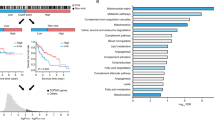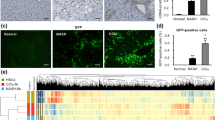Abstract
Background
The incidence of hepatocellular carcinoma (HCC) associated with metabolic risk factors, such as diabetes and obesity, has been increasing. However, the underlying mechanism that links these diseases remains unclear.
Methods
We performed genome-wide expression analysis of human liver tissues of non-viral HCC patients with or without metabolic risk factors. The upregulated genes that associated with diabetes and obesity were investigated by in vitro and in vivo experiments, and immunohistochemistry of human liver tissues was performed.
Results
Among the upregulated genes, connective tissue growth factor (CTGF) expression was induced to a greater extent by combined glucose and insulin administration to human hepatoma cells. Genome-wide expression analysis revealed upregulation of a chemokine network in CTGF-overexpressing hepatoma cells, which displayed an increased ability to induce in vitro activation of macrophages, and in vivo infiltration of liver macrophages. Immunohistochemistry of human liver tissues validated the correlations between CTGF expression and diabetes or obesity as well as activation of liver macrophages in patients with non-viral HCC. Recurrence-free survival was significantly poorer in the CTGF-positive patients compared with the CTGF-negative patients (p = 0.002). Multivariate analysis determined that CTGF expression (HR 2.361; 95 % CI 1.195–4.665; p = 0.013) and vascular invasion (HR 2.367; 95 % CI 1.270–4.410; p = 0.007) were independent prognostic factors for recurrence of non-viral HCC.
Conclusions
Our data suggest that CTGF could be involved in oncogenic pathways promoting non-viral HCC associated with metabolic risk factors via induction of liver inflammation and is expected to be a novel HCC risk biomarker and potential therapeutic target.





Similar content being viewed by others

Abbreviations
- HCC:
-
Hepatocellular carcinoma
- CTGF:
-
Connective tissue growth factor
- cDNA:
-
Complementary DNA
- ITGBL1:
-
Integrin, beta-like 1
- LIMA1:
-
LIM domain and actin binding 1
- SLAMF7:
-
SLAM family, member 7
- GAPDH:
-
Glyceraldehyde-3-phosphate dehydrogenase
- GO:
-
Gene ontology
- DAVID:
-
Database for Annotation, Visualization and Integrated Discovery
- DM:
-
Diabetes mellitus
- BMI:
-
Body mass index
- GSEA:
-
Gene set enrichment analysis
- NF-κB:
-
Nuclear factor-kappa B
- JAK/STAT:
-
Janus kinase/signal transducer and activator of transcription
- PI3K:
-
Phosphatidylinositol 3 kinase
References
El-Serag HB, Rudolph KL. Hepatocellular carcinoma: epidemiology and molecular carcinogenesis. Gastroenterology. 2007;132:2557–76.
Jemal A, Bray F, Center MM, et al. Global cancer statistics. CA Cancer J Clin. 2011;61:69–90 (Erratum in: CA Cancer J Clin 2011;61:134).
Davis GL, Dempster J, Meler JD, et al. Hepatocellular carcinoma: management of an increasingly common problem. Proc (Bayl Univ Med Cent). 2008;21:266–80.
Dyson J, Jaques B, Chattopadyhay D, et al. Hepatocellular cancer: the impact of obesity, type 2 diabetes and a multidisciplinary team. J Hepatol. 2014;60:110–7.
Caldwell SH, Crespo DM, Kang HS, et al. Obesity and hepatocellular carcinoma. Gastroenterology. 2004;127:S97–103.
Vanni E, Bugianesi E. Obesity and liver cancer. Clin Liver Dis. 2014;18:191–203.
Weng CJ, Hsieh YH, Tsai CM, et al. Relationship of insulin-like growth factors system gene polymorphisms with the susceptibility and pathological development of hepatocellular carcinoma. Ann Surg Oncol. 2010;17:1808–15.
Karagozian R, Derdák Z, Baffy G. Obesity-associated mechanisms of hepatocarcinogenesis. Metabolism. 2014;63:607–17.
Stickel F, Hellerbrand C. Non-alcoholic fatty liver disease as a risk factor for hepatocellular carcinoma: mechanisms and implications. Gut. 2010;59:1303–7.
Naugler WE, Sakurai T, Kim S, et al. Gender disparity in liver cancer due to sex differences in MyD88-dependent IL-6 production. Science. 2007;317:121–4 (Erratum in: Science 2009;326:1346).
Park EJ, Lee JH, Yu GY, et al. Dietary and genetic obesity promote liver inflammation and tumorigenesis by enhancing IL-6 and TNF expression. Cell. 2010;140:197–208.
Glinsky GV, Berezovska O, Glinskii AB. Microarray analysis identifies a death-from-cancer signature predicting therapy failure in patients with multiple types of cancer. J Clin Invest. 2005;115:1503–21.
Tanaka S, Arii S, Yasen M, et al. Aurora kinase B is a predictive factor for the aggressive recurrence of hepatocellular carcinoma after curative hepatectomy. Br J Surg. 2008;95:611–9.
Murakata A, Tanaka S, Mogushi K, et al. Gene expression signature of the gross morphology in hepatocellular carcinoma. Ann Surg. 2011;253:94–100.
Furuta K, Sato S, Yamauchi T, et al. Changes in intrahepatic gene expression profiles from chronic hepatitis to hepatocellular carcinoma in patients with hepatitis C virus infection. Hepatol Res. 2008;38:673–82.
Perbal B. CCN proteins: multifunctional signalling regulators. Lancet. 2004;363:62–4.
Tanaka S. CCN4 and CCN6 variants in Wnt-inducible signaling pathway. In: Perbal P, Takigawa M, editors. CCN proteins: a new family of cell growth and differentiation regulators. London: Imperial College Press; 2005. p. 293–304.
Tanaka S, Pero SC, Taguchi K, et al. Specific peptide ligand for Grb7 signal transduction protein and pancreatic cancer metastasis. J Natl Cancer Inst. 2006;98:491–8.
Ogawa K, Tanaka S, Matsumura S, et al. EpCAM-targeted therapy for human hepatocellular carcinoma. Ann Surg Oncol. 2014;21:1314–22.
Aihara A, Tanaka S, Yasen M, et al. The selective Aurora B kinase inhibitor AZD1152 as a novel treatment for hepatocellular carcinoma. J Hepatol. 2010;52:63–71.
Coulouarn C, Lefebvre G, Daveau R, et al. Genome-wide response of the human Hep3B hepatoma cell to proinflammatory cytokines, from transcription to translation. Hepatology. 2005;42:946–55.
Slany A, Haudek VJ, Zwickl H, et al. Cell characterization by proteome profiling applied to primary hepatocytes and hepatocyte cell lines Hep-G2 and Hep-3B. J Proteome Res. 2010;9:6–21.
Tanaka S, Wands JR. Insulin receptor substrate 1 overexpression in human hepatocellular carcinoma cells prevents transforming growth factor beta1-induced apoptosis. Cancer Res. 1996;56:3391–4.
Byun JK, Choi YK, Kang YN, et al. Retinoic acid-related orphan receptor alpha reprograms glucose metabolism in glutamine-deficient hepatoma cells. Hepatology. 2015;61:953–64.
Tanaka S, Mogushi K, Yasen M, et al. Oxidative stress pathways in noncancerous human liver tissue to predict hepatocellular carcinoma recurrence: a prospective, multicenter study. Hepatology. 2011;54:1273–81.
Jun JI, Lau LF. Taking aim at the extracellular matrix: CCN proteins as emerging therapeutic targets. Nat Rev Drug Discov. 2011;10:945–63.
Sánchez-López E, Rayego S, Rodrigues-Díez R, et al. CTGF promotes inflammatory cell infiltration of the renal interstitium by activating NF-kappaB. J Am Soc Nephrol. 2009;20:1513–26.
Wang J, Leclercq I, Brymora JM, et al. Kupffer cells mediate leptin-induced liver fibrosis. Gastroenterology. 2009;137:713–23.
Murphy M, Godson C, Cannon S, et al. Suppression subtractive hybridization identifies high glucose levels as a stimulus for expression of connective tissue growth factor and other genes in human mesangial cells. J Biol Chem. 1999;274:5830–4.
Wahab NA, Schaefer L, Weston BS, et al. Glomerular expression of thrombospondin-1, transforming growth factor beta and connective tissue growth factor at different stages of diabetic nephropathy and their interdependent roles in mesangial response to diabetic stimuli. Diabetologia. 2005;48:2650–60.
Kuiper EJ, van Zijderveld R, Roestenberg P, et al. Connective tissue growth factor is necessary for retinal capillary basal lamina thickening in diabetic mice. J Histochem Cytochem. 2008;56:785–92.
Liu X, Luo F, Pan K, et al. High glucose upregulates connective tissue growth factor expression in human vascular smooth muscle cells. BMC Cell Biol. 2007;16(8):1.
Liu SC, Hsu CJ, Fong YC, et al. CTGF induces monocyte chemoattractant protein-1 expression to enhance monocyte migration in human synovial fibroblasts. Biochim Biophys Acta. 2013;1833:1114–24.
Chujo S, Shirasaki F, Kondo-Miyazaki M, et al. Role of connective tissue growth factor and its interaction with basic fibroblast growth factor and macrophage chemoattractant protein-1 in skin fibrosis. J Cell Physiol. 2009;220:189–95.
Charrier A, Chen R, Kemper S, et al. Regulation of pancreatic inflammation by connective tissue growth factor (CTGF/CCN2). Immunology. 2014;141:564–76.
Paradis V, Perlemuter G, Bonvoust F, et al. High glucose and hyperinsulinemia stimulate connective tissue growth factor expression: a potential mechanism involved in progression to fibrosis in nonalcoholic steatohepatitis. Hepatology. 2001;34:738–44.
Lo L, McLennan SV, Williams PF, et al. Diabetes is a progression factor for hepatic fibrosis in a high fat fed mouse obesity model of non-alcoholic steatohepatitis. J Hepatol. 2011;55:435–44.
Chen L, Charrier AL, Leask A, et al. Ethanol-stimulated differentiated functions of human or mouse hepatic stellate cells are mediated by connective tissue growth factor. J Hepatol. 2011;55:399–406.
Llovet JM, Villanueva A, Lachenmayer A, et al. Advances in targeted therapies for hepatocellular carcinoma in the genomic era. Nat Rev Clin Oncol. 2015;12:408–24.
Barashi N, Weiss ID, Wald O, et al. Inflammation-induced hepatocellular carcinoma is dependent on CCR5 in mice. Hepatology. 2013;58:1021–30.
He G, Dhar D, Nakagawa H, et al. Identification of liver cancer progenitors whose malignant progression depends on autocrine IL-6 signaling. Cell. 2013;155:384–96.
Yoshimoto S, Loo TM, Atarashi K, et al. Obesity-induced gut microbial metabolite promotes liver cancer through senescence secretome. Nature. 2013;499:97–101.
Perng DW, Wu YC, Tsai CC, et al. Bile acids induce CCN2 production through p38 MAP kinase activation in human bronchial epithelial cells: a factor contributing to airway fibrosis. Respirology. 2008;13:983–9.
Neesse A, Frese KK, Bapiro TE, et al. CTGF antagonism with mAb FG-3019 enhances chemotherapy response without increasing drug delivery in murine ductal pancreas cancer. Proc Natl Acad Sci USA. 2013;110:12325–30.
Adler SG, Schwartz S, Williams ME, et al. Phase 1 study of anti-CTGF monoclonal antibody in patients with diabetes and microalbuminuria. Clin J Am Soc Nephrol. 2010;5:1420–8.
Acknowledgments
We thank Dr. Masahisa Jinushi at Keio University and Dr. Shinya Suzu at Kumamoto University for advice and support about human macrophage experiments. We also thank Ms. Ayumi Shioya and Ms. Hiromi Nagasaki for technical assistance. This work was supported by Scientific Research (A) from the Ministry of Education, Culture, Sports, Science and Technology of Japan; Health and Labour Sciences Research Grant from the Ministry of Health Labour and Welfare of Japan (Research on Hepatitis) and AMED (Japan Agency for Medical Research and Development).
Author information
Authors and Affiliations
Corresponding author
Ethics declarations
Conflict of interest
The authors disclose no conflicts of interests.
Electronic supplementary material
Below is the link to the electronic supplementary material.
Rights and permissions
About this article
Cite this article
Akahoshi, K., Tanaka, S., Mogushi, K. et al. Expression of connective tissue growth factor in the livers of non-viral hepatocellular carcinoma patients with metabolic risk factors. J Gastroenterol 51, 910–922 (2016). https://doi.org/10.1007/s00535-015-1159-8
Received:
Accepted:
Published:
Issue Date:
DOI: https://doi.org/10.1007/s00535-015-1159-8



